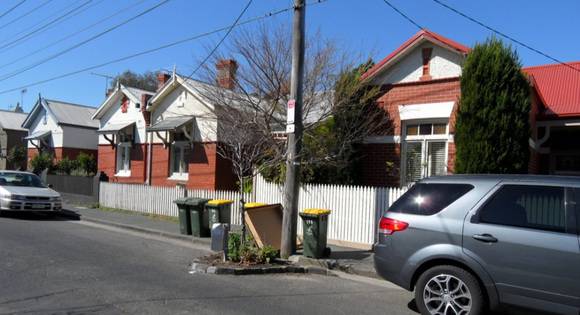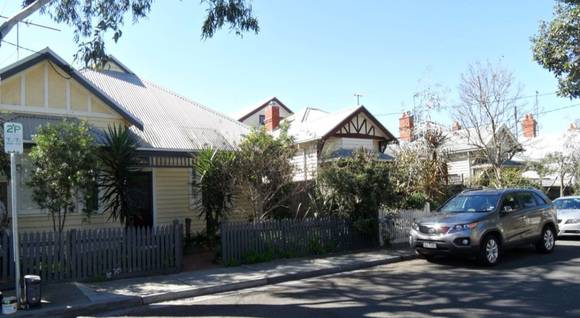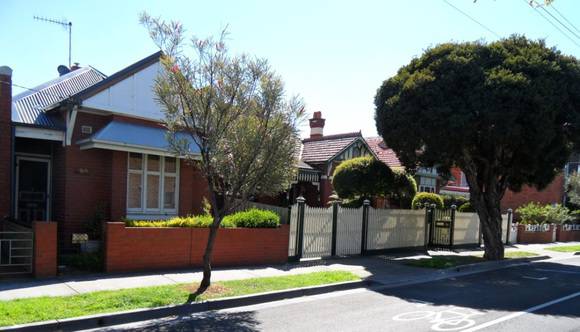| Back to search results » | Back to search page » |
|
Bell Street Precinct
Location1-29 & 2-22 BELL STREET, and 1A & 1-11 BENSON STREET, and 170-210 COPPIN STREET, and 139-157 MARY STREET, RICHMOND, YARRA CITY LevelRecommended for Heritage Overlay |
|
Statement of Significance
What is significant? Contributory buildings have typically: - Gable-fronted roofs for single-fronted houses, or high hip roofs with a projecting front gable for double-fronted, The following buildings are Individually Significant and have their own statement of significance: - 15-21 Bell Street, and The following properties are Not Contributory: 7-13 & 10 Bell Street, 1A Benson Street, 182 Coppin Street, and 143 Mary Street. How it is significant? Why it is significant? Architecturally, the precinct is representative of the speculative housing estates of the early twentieth century, mainly comprising terraces or rows of duplex and detached houses built either to identical design or with a certain amount of pleasing variety in details and forms. The houses within the precinct demonstrate the principal characteristics of Edwardian-era domestic architecture, particularly the predominance of gable fronts (either to single-fronted cottages or asymmetrical villas), the use of red face brick with render dressings or areas of roughcast render, casement windows often with highlights, the use of bold timber fretwork and shaped timber posts to verandahs, and faux half timbering to gables. (Criterion D) Aesthetically, a number of the houses display unusual or particularly high quality detail, including the jettied gables and bold arched verandah friezes of Elly Lesser's rows (196-202 Coppin Street, 15-21 Bell Street), the basket-weave fretwork to the villa at 170 Coppin Street, the render detail to 210 Coppin Street, the jerkin-head gables and attic-style form of 204-208 Coppin Street, the brickwork details, window hoods and Tudor-arched verandah friezes of 145-157 Mary Street, and the sinuous incised design of the timber verandah frieze of 139 Mary Street. The consistent rows of houses by a single builder add to the visual cohesion of the precinct. (Criterion E)
The Bell Street Precinct, comprising 1-29 & 2-22 Bell Street, 1A & 1-11 Benson Street, 170-210 Coppin Street, and 139-157 Mary Street, Richmond, is significant. The precinct contains timber and red brick dwellings predominantly from the Federation/Edwardian era, some with Queen Anne styling and the later examples demonstrating a transition to Arts & Crafts and bungalow styles. The housing in the precinct was constructed between 1910 and 1920, some of it in rows or groups by a single designer.
- One storey wall heights,
-Face brick, weatherboard, some ashlar timber boards and roughcast render accents, most with faux half-timbering to the gable,
- Corrugated iron roofing,
- Chimneys of red face brick with corbelled capping course or a cap of roughcast render,
- Post-supported verandah elements facing the street, many with elaborate timber friezes,
- Double or tripartite casement windows with highlights (often of coloured glass or leadlight), many beneath a decorative window hood, and
- Less than 40% of the street wall face comprised with openings such as windows and doors.
- 204-208 Coppin Street.
The Bell Street Precinct is of local historical, and architectural/aesthetic significance to the City of Yarra.
The precinct provides tangible evidence of the housing boom of the early twentieth century in Richmond, when the expansion of manufacturing led to significant population growth and demand for housing. In particular the precinct illustrates the prevalence of speculatively built developments erected in response to the overwhelming housing need. It illustrates the better class of dwellings erected in this period, seen particularly in the villas along Coppin Street, but also in the rows of finely detailed identical brick cottages built for pawnbroker and financier Elly Lesser on Bell Street and the architect-designed row on Mary Street. The sole use of brick as a building material along Coppin Street demonstrates the effect of the council by-law of 1886 banning timber construction along a number of major streets in Richmond. (Criterion A)
Group
Residential buildings (private)
Category
Residential Precinct






